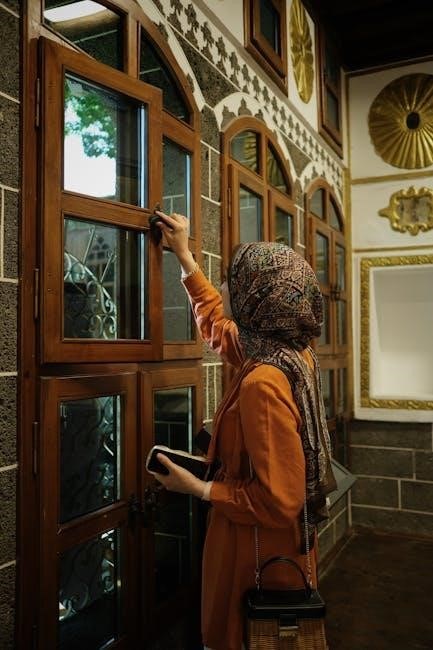johari window pdf

The Johari Window is a psychological model created by Joseph Luft and Harry Ingham to enhance self-awareness and improve communication in personal and professional relationships.
Overview of the Johari Window Model
The Johari Window is a psychological model designed to enhance self-awareness and improve communication in personal and professional relationships. Developed by Joseph Luft and Harry Ingham in the 1950s, it consists of four quadrants representing different levels of awareness. The model helps individuals understand what is known or unknown by themselves and others, fostering personal growth and effective communication. It is widely used in team building, leadership development, and interpersonal relationships to promote openness and reduce misunderstandings.
Historical Background and Developers

The Johari Window was developed in the 1950s by American psychologists Joseph Luft and Harry Ingham. Initially introduced as a tool for group development, it aimed to enhance interpersonal awareness and communication. The model gained popularity for its simplicity in understanding self-awareness and its application in personal and professional contexts. Luft and Ingham’s work laid the foundation for its use in various fields, including leadership development, team building, and personal growth, making it a timeless framework for self-improvement.
Importance of Self-Awareness in Communication
Self-awareness is crucial for effective communication, as it allows individuals to understand their own emotions, motivations, and behaviors. By recognizing what is known and unknown about oneself, individuals can express themselves more authentically and build trust in relationships. The Johari Window highlights how self-awareness fosters clearer interactions, reduces misunderstandings, and enhances emotional intelligence. This awareness is the cornerstone of personal and professional growth, enabling individuals to adapt and improve their communication strategies in diverse situations.

The Four Quadrants of the Johari Window
The Johari Window consists of four quadrants: the Open Area, Blind Spot, Hidden Area, and Unknown Area. Each represents different levels of self-awareness and interpersonal understanding.

Quadrant I: The Open Area
Quadrant I, or the Open Area, represents behaviors, feelings, and motivations that are known to both the individual and others. This area fosters transparency and trust, enabling effective communication and strong relationships. Expanding this quadrant is crucial for personal and professional growth, as it promotes mutual understanding and collaboration.
Quadrant II: The Blind Spot
Quadrant II, or the Blind Spot, consists of traits, behaviors, or emotions that are known to others but not to the individual. This area often includes unconscious habits or unrecognized strengths and weaknesses. Feedback from others is essential for reducing this quadrant, as it enhances self-awareness and improves interpersonal relationships. By addressing blind spots, individuals can gain deeper insights into their behavior and foster personal and professional growth through increased understanding and communication.
Quadrant III, or the Hidden Area, represents aspects of oneself that are known internally but concealed from others. This can include feelings, thoughts, or experiences that individuals choose not to disclose. While this quadrant can serve as a protective mechanism, excessive secrecy may hinder personal connections and team collaboration. Self-reflection and trust-building relationships can help reduce this area, fostering openness and deeper communication. Quadrant IV, or the Unknown Area, contains aspects of oneself that are neither known to the individual nor to others. This includes untapped potential, unconscious feelings, or unrecognized abilities. It often requires external feedback or self-discovery to uncover these hidden traits. Exploring this quadrant can lead to personal growth and improved relationships, as it reveals new insights into one’s capabilities and emotions that were previously unacknowledged. It highlights the importance of continuous learning and self-reflection in personal development. The Johari Window is widely used in team building, leadership development, and personal growth. It helps individuals and teams understand strengths, weaknesses, and communication patterns to enhance collaboration and self-awareness. The Johari Window is a powerful tool for team building and group development. By identifying the open, blind, hidden, and unknown areas, team members can share feedback and insights, fostering trust and collaboration. This model encourages open communication, helping teams to leverage each other’s strengths and address weaknesses collectively. Regular use of the Johari Window in group settings promotes a culture of transparency and continuous improvement, leading to more effective teamwork and shared success. The Johari Window is a valuable tool for personal growth and self-improvement. By exploring the open, hidden, blind, and unknown areas, individuals can gain deeper insights into their behavior, motivations, and emotions. This model encourages self-reflection and the identification of strengths and weaknesses. By expanding the open area, individuals can enhance their self-awareness, fostering personal development and emotional intelligence. Regular use of the Johari Window helps individuals set goals for improvement and achieve greater self-understanding, leading to a more authentic and fulfilling life. The Johari Window Questionnaire is a self-assessment tool designed to help individuals identify their personality traits and behaviors. It typically consists of numerical items with statements marked A and B, where participants assign point values to each. The goal is to gain insights into one’s strengths, weaknesses, and areas for improvement, fostering self-awareness and personal development through structured reflection and analysis. Carefully read each numbered item and its statements marked A and B. After completing the Johari Window questionnaire, analyze the distribution of points across the four quadrants. The Open Area reflects traits known to yourself and others, indicating strong communication. The Blind Spot reveals aspects others see but you don’t, suggesting areas for feedback. The Hidden Area shows traits you know but others don’t, highlighting potential for deeper connections. The Unknown Area represents unconscious traits, requiring self-reflection. Use these insights to enhance self-awareness, improve relationships, and guide personal growth. Sketch a grid with two axes: known to self and known to others. Label the four quadrants and plot your traits, feelings, and behaviors to visualize self-awareness. Draw a large square and divide it into four equal quadrants using a vertical and horizontal line. After plotting your traits in the Johari Window, analyze each quadrant to identify patterns and insights. The Open Area reveals strengths and transparent behaviors, while the Blind Spot highlights areas for feedback and self-improvement. The Hidden Area suggests qualities you might share to deepen relationships. The Unknown Area invites exploration through reflection or feedback. Reflecting on these results fosters self-awareness, helping you communicate more effectively and build stronger connections with others. Regular analysis encourages personal and professional growth. A team used the Johari Window to identify a member’s blind spots, improving communication and collaboration. This real-world application showcased the model’s effectiveness in enhancing interpersonal relationships and productivity. A team leader used the Johari Window to address communication issues within a newly formed team. By identifying a team member’s blind spot regarding their tendency to dominate meetings, the leader facilitated open feedback sessions. This increased the open area of the team’s collective awareness, fostering better collaboration and reducing conflicts. The practical application of the model enhanced trust and productivity, demonstrating its effectiveness in real-world scenarios. The Johari Window facilitates increased self-awareness and fosters open communication, leading to improved interpersonal relationships. Teams learn the importance of feedback and trust, while individuals gain insights into their strengths and areas for growth. The model highlights how reducing blind spots and hidden areas enhances collaboration and understanding. Regular application of the Johari Window promotes personal and professional development, creating a culture of transparency and continuous improvement. Its practical outcomes include stronger team dynamics and individual empowerment. The Johari Window is a powerful tool for enhancing self-awareness and communication, fostering personal and professional growth. Its insights promote transparency and understanding, encouraging continuous development. The Johari Window offers a framework for understanding self-awareness and interpersonal relationships. It helps identify strengths, weaknesses, and emotions, fostering personal growth and improved communication. By revealing blind spots and hidden areas, it enhances transparency and trust in teams. Its practical applications in team development and personal growth make it a valuable tool for both individuals and organizations, promoting emotional intelligence and collaboration. Regular use of the model encourages continuous self-reflection and development. Regular use of the Johari Window fosters a culture of openness, helping individuals and teams grow. It encourages self-reflection, revealing blind spots and hidden strengths, which are crucial for personal and professional development. By applying this model, individuals can enhance emotional intelligence, improve communication, and build trust. Continuous use empowers individuals to take ownership of their growth, leading to better relationships and a more collaborative environment. It serves as a timeless tool for fostering awareness and development in both personal and organizational contexts.Quadrant III: The Hidden Area

Quadrant IV: The Unknown Area
Practical Applications of the Johari Window
Team Building and Group Development
Personal Growth and Self-Improvement

Johari Window Questionnaire
Instructions for Completing the Questionnaire
Assign a point value to the A and B statements based on your self-assessment.
Ensure honesty and accuracy in your responses to gain meaningful insights.
Reflect on the results to identify areas for personal growth and self-awareness.
This structured approach helps individuals understand their traits and behaviors, fostering self-improvement and interpersonal understanding.Interpreting the Results for Self-Awareness

Creating Your Personal Johari Window

Step-by-Step Guide to Drawing the Window
Label the axes: the vertical for known to others and the horizontal for known to self.
Identify and list traits, feelings, or behaviors you want to assess.
Plot each item in the appropriate quadrant based on its visibility to yourself and others.
Reflect on the distribution to identify areas for growth and improved communication.
Regularly update your window to track personal development and increased self-awareness.Analyzing and Reflecting on the Results

Case Study: Johari Window in Action
Example of Applying the Model in a Real-World Scenario
Lessons Learned and Outcomes

Summarizing the Key Benefits of the Johari Window
Encouraging Continuous Use for Personal and Professional Development



Leave a Reply
You must be logged in to post a comment.